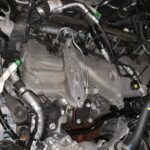Camshafts are essential components in the intricate machinery of a combustion engine, often referred to as the “Cam In Motor” by mechanics and enthusiasts alike. These seemingly simple parts play a crucial role in the engine’s operation, but what exactly is a camshaft, and why is it so vital to your vehicle’s performance?
From Ancient Innovation to Modern Engines
Most people are familiar with the basic concept of a combustion engine: fuel and air are mixed, ignited within a cylinder, and the resulting explosion drives a piston, converting energy into motion via the crankshaft and transmission system. While this sounds straightforward, the internal combustion engine has undergone centuries of development, evolving into a highly complex system. Within this system, the camshaft stands out as a relatively old yet consistently essential component. Its fundamental principle dates back to 13th century Turkey, where the ingenious inventor Ismail al-Jazari utilized cam mechanisms in various devices, detailed in his seminal work, ‘Book of Knowledge of Ingenious Mechanical Devices’. Remarkably, the core operational principles of the “cam in motor” remain unchanged from al-Jazari’s time to the advanced engines of the 21st century, highlighting the enduring effectiveness of this invention.
The Symphony of Shape and Synchronicity
A camshaft is, at its core, a precisely engineered rod or shaft featuring a series of shaped protrusions known as cam lobes. These lobes are strategically positioned along the shaft. As the camshaft rotates, the unique shape of each cam lobe dictates its interaction with a valve or switch. The degree of action, whether opening a valve wider or activating a switch more fully, directly corresponds to the cam lobe’s profile. The speed of the camshaft’s rotation governs the frequency of these actions.
In contemporary internal combustion engines, camshafts are typically located above the cylinder banks, though configurations can vary. Their primary function is to control the engine valves with utmost precision. This control is paramount for regulating the intake of the air-fuel mixture into the combustion chamber and ensuring the efficient expulsion of exhaust gases after combustion, preparing the cylinder for the next cycle.
The “cam in motor” is not merely critical for engine operation; its precise synchronization with piston movement profoundly affects engine performance. The opening and closing of valves must be perfectly timed with the pistons’ cycles. To achieve this critical timing, the camshaft is linked to the crankshaft—which directly drives the pistons—via a timing belt or chain. Furthermore, the shape of the cam lobes themselves is meticulously designed to govern the rate at which the valves open and close. This sophisticated control over valve timing is commonly known as variable valve timing, a key technology in modern engines.
The fundamental operation of a cam mechanism.
The Advantage of Multiple Cams
The number of camshafts within an engine can vary depending on factors like cylinder arrangement and valve configuration. At a minimum, one camshaft is required per cylinder bank. Inline engines, for example, may operate with a single camshaft, whereas V-shaped engine configurations necessitate at least two. Some high-performance engines employ double overhead camshafts (DOHC), resulting in as many as four camshafts across two cylinder banks.
While adding an extra camshaft per bank (moving from SOHC to DOHC) introduces added weight and cost, it offers significant advantages. Double Overhead Camshaft (DOHC) designs provide greater flexibility in component placement, leading to improved engine efficiency, enhanced high-end power, and a simplified valve actuation system, especially in engines utilizing more than two valves per cylinder.
Four valves per cylinder has become a prevalent design choice due to its efficiency in maximizing cylinder head space utilization for improved airflow. While a Single Overhead Camshaft (SOHC) design can also manage four valves per cylinder, it necessitates a more complex arrangement of rocker arms and linkages. Consequently, DOHC configurations are generally favored for their direct valve actuation and performance benefits in multi-valve engines.
An illustration of a complete SOHC system in action.
The Evolving Landscape of Camshaft Technology
DOHC configurations have paved the way for the integration of advanced valve technology, allowing for dynamic adjustments to valve timing, duration, and lift. This enhanced control translates to tangible benefits, including improved fuel economy, increased power output, and reduced emissions, optimizing engine performance across various driving conditions.
Variable valve timing and lift technologies represent a major leap forward in engine design in recent years. Virtually every automotive manufacturer has developed their own iterations of these systems, focusing on refining different aspects of the engine’s valve timing mechanism. Some systems employ multiple cam lobe profiles and switch between them based on engine load, optimizing for either fuel efficiency or power. Others adjust the timing relationship between the crankshaft and camshafts to modulate engine performance characteristics. Early variable valve timing systems even utilized oil pressure to manipulate valve operation.
The optimal variable valve timing system is still a subject of ongoing development and refinement. However, it is clear that these technologies will continue to proliferate in engine designs as the relentless pursuit of greater efficiency, power, and reduced environmental impact drives innovation. The “cam in motor,” though a component with a long history, remains at the heart of these advancements, constantly being reimagined and refined to meet the demands of modern engines.
MAT FOUNDRY GROUP: Leaders in Automotive Component Manufacturing
MAT FOUNDRY GROUP stands as a leading manufacturer of high-quality grey and ductile iron car components, including precision-engineered camshafts. To discover more about our capabilities and product offerings, please explore our PRODUCTS section or CONTACT US today for further information.
